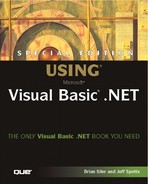Chapter 20. Database Basics
In this chapter
Introducing the Structured Query Language
Most business-oriented applications work with data in one form or another. We’re not talking about computer data like a loop counter variable, but actual business information, such as the number of units sold or customer name. For business data stored on a computer to be useful, you need a system that allows you to efficiently analyze and maintain it. A database management system (or database for short) is one way to store such data.
This is the first of four chapters in this book related to databases. As you will learn, Visual Basic .NET can create powerful data management programs with a little planning and effort. The most fundamental part of that planning is in how the database is structured. A poorly designed database can doom even the most well-intentioned program from the start. On the other hand, a well-designed database can make a programmer’s life much easier.
Another key issue with managing data is using the database to answer queries. In the second half of this chapter, we will introduce the Structured Query Language (SQL). By learning a few SQL commands, you can retrieve information from a database and issue commands to manipulate the data contained within it.
